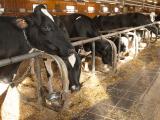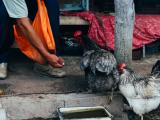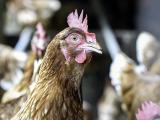Oct 6, 2006 (CIDRAP News) – In a development that could complicate avian influenza control efforts, an Indonesian official said this week that some apparently healthy chickens showed evidence of H5N1 virus infection, according to the Jakarta Post.
Rachmat Setiadi, who heads the West Java Animal Husbandry Office, announced the findings 2 days ago after serologic testing of 20 chickens around the home of two people from Bandung who died of H5N1 infection at the end of September, the newspaper reported yesterday.
"The test has shown that four healthy chickens were infected with H5N1. We should be more cautious," Setiadi was quoted as saying. He also said healthy chickens with H5N1 were found in other cities and regencies, but he didn't name them.
Setiadi said the finding means that healthy chickens could carry the virus, according to the story. He recommended that residents stop keeping chickens in their backyards or near their homes. The Post reported that of Bandung's 26 cities and regencies, only two were free of H5N1 virus in poultry.
The story did not indicate whether actual H5N1 viruses were isolated from the chickens. Serologic evidence of infection usually means the presence of antibodies to the virus, which suggests the host was exposed to the virus at some point but doesn't necessarily mean the host is a current carrier.
Though the Asian strain of H5N1 is usually lethal in chickens, there has been at least one other report of asymptomatic chickens testing positive for the virus. In February, researchers reported that they found H5N1 viruses in apparently healthy chickens in live-bird markets in southern China. The researchers had analyzed flu viruses collected from thousands of wild and domestic birds in China and Hong Kong (see link below).
The human H5N1 deaths that Setiadi referred to appear to be connected to an outbreak in Bandung that raised suspicions of a family cluster. A 20-year-old man was confirmed by the World Health Organization (WHO) on Sep 27 as Indonesia's 68th case-patient; he died later that day and was the country's 52nd victim. His 23-year-old brother died of similar respiratory symptoms on Sep 24, but he was buried before samples could be collected for testing. Their 15-year-old sister was hospitalized with a fever and cough the same week, but tests suggested she had seasonal influenza.
The brothers were reported to have fed dead chickens to their dogs. The head of Bandung's agriculture office, Yogi Supardjo, told the Post that tests on 11 dogs kept by the family came back negative.
In another Indonesian development, an analysis of H5N1 viruses from birds on Sumatra, Java, and Bali islands indicated that the virus has not mutated to become more transmissible to people, the Indonesian agriculture ministry said yesterday.
The ministry said tests on 49 samples showed no major changes in the virus, according to a Bloomberg News report yesterday. The analysis was done by a World Organization for Animal Health (OIE) reference laboratory in Geelong, Australia, the story said.
The samples were collected between September 2005 and March 2006, Elly Sawitri, an agriculture ministry official, told Bloomberg. Officials plan to submit additional samples collected in the past 6 months for analysis.
In other news, the WHO on Oct 3 confirmed Indonesia's 69th human case of H5N1 disease, in a 21-year-old woman from East Java. Indonesian officials had reported the case Sep 29.
The woman became ill on Sep 19 and was hospitalized 6 days later. She is the sister of an 11-year-old boy who died of H5N1 infection on Sep 18. The WHO said the boy's death prompted contact tracing, which revealed that his sister was ill. She was given the antiviral medication oseltamivir and isolated in a hospital.
The WHO said poultry deaths in the family were noted before and after the brother's illness, and though the woman was probably exposed to poultry, the source of her infection was under investigation.
Elsewhere in Indonesia, seven people with possible avian flu symptoms have been admitted to a hospital in South Sulawesi, the Jakarta Post reported today.
Most of the patients are younger than 10 and have high fever and vomiting, the Post reported. A hospital representative said avian flu was suspected on the basis of signs and symptoms, but blood samples from the seven patients were negative for the H5N1 virus. He said nasal samples from the patients were sent to a lab in Jakarta for analysis.
Family members reported that sick and dead chickens were found near the patients' homes.
Meanwhile, China has reported another H5N1 outbreak in poultry, according to an Agence France-Presse article yesterday. The outbreak involved 1,000 poultry in a village in northern China's Ningxia Hui region. The Chinese news agency Xinhua reported that 72,930 domestic poultry were culled to control the outbreak.
An outbreak that came to light last week affected 985 chickens in northern China's Inner Mongolia Autonomous Region, Xinhua reported. The two outbreaks are the first in about 6 weeks.
See also:
Sep 27 WHO statement
http://www.who.int/csr/don/2006_09_27a/en/index.html
Feb 10 Proceedings of the National Academy of Sciences article with information about apparently healthy chickens infected with H5N1: "Establishment of multiple sublineages of H5N1 influenza virus in Asia: implications for pandemic control" [Abstract]
Feb 10, 2006, CIDRAP News story "Report depicts China as launching pad for avian flu"
Oct 3 WHO statement
http://www.who.int/csr/don/2006_10_03/en/index.html



















